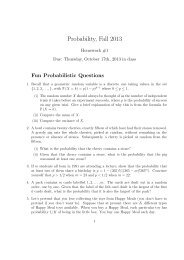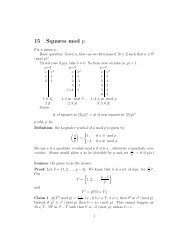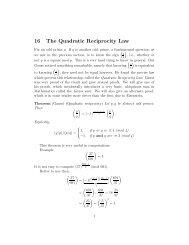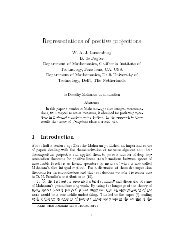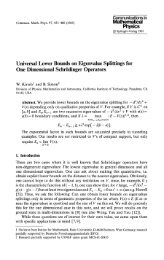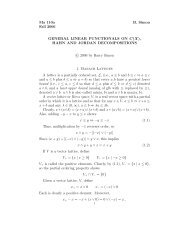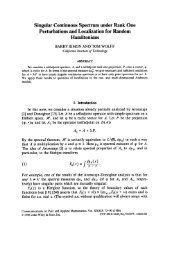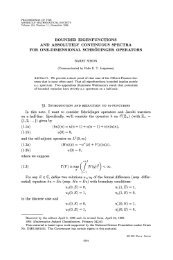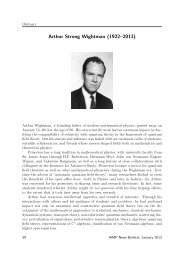1 Introduction - Mathematics Department - Caltech
1 Introduction - Mathematics Department - Caltech
1 Introduction - Mathematics Department - Caltech
You also want an ePaper? Increase the reach of your titles
YUMPU automatically turns print PDFs into web optimized ePapers that Google loves.
258 A. POLTORATSKI, B. SIMON AND M. ZINCHENKO<br />
and the intersection lies in I ∪ Ĩ. Thus,<br />
(3.36) |Ŵt0 ∩ e ∩ I♯ | ≥ |e ∩ (x0 − a, x0 + a)| − |(I ∪ Ĩ) \ Ŵt0 |.<br />
Since I ⊂ Ŵt ⊂ Ŵt0 ,<br />
δ<br />
(3.37) |(I ∪ Ĩ) \ Ŵt0 | = |Ĩ \ Ŵt0 | ≤<br />
2 |I|<br />
by (3.19); (3.35) and (3.36) imply (3.34). <br />
Proof of Theorem 1.4. Suppose µ = 0. On R \ A, Fµ(x + i0) is continuous<br />
and real, so {x : |Fµ(x + i0)| > t} is open, and hence a countable union of maximal<br />
disjoint open intervals.<br />
Let I = [c − a, c + a] be the closure of any such interval. On R \ A, Fµ(x) has<br />
(3.38) F ′ <br />
µ(x) =<br />
dµ(x)<br />
> 0.<br />
(y − x) 2<br />
If Fµ > t on I, c + a must be in A or else Fµ(c + a) < ∞ and Fµ(c + a + ε) ∈ Ŵt<br />
for ε small (so I is not maximal). Similarly, if Fµ < −t on I, c − a ∈ A. Thus,<br />
I ∩ A = ∅, so I ∩ e = ∅.<br />
Let<br />
(3.39) T = πCµ<br />
diam(e) ,<br />
where C is the constant in (1.4). Then for t > T, |Ŵt| ≤ diam(e), so a ≤ diam(e).<br />
Thus, by Proposition 3.4,<br />
(3.40) |Ŵt0 ∩ e ∩ I♯ | ≥ δ<br />
2 |I|.<br />
Clearly, the I’s and so the (I ♯ ) int ’s are an open cover of Ŵt\A. Thus, by the Vitali<br />
covering theorem (see Rudin [13, Lemma 7.3]), we can find a subset of mutually<br />
}) such that<br />
disjoint I ♯ ’s (call them {I ♯<br />
j<br />
(3.41) |Ŵt| ≤ 4 <br />
j<br />
|I ♯<br />
j<br />
By the disjointness, with t0 given by (3.16),<br />
<br />
|Ŵt0 ∩ e| ≥<br />
j<br />
≥ δ<br />
2<br />
<br />
| ≤ 12 |Ij|.<br />
|I ♯<br />
j ∩ Ŵt0 ∩ e|<br />
<br />
|Ij| (by (3.34))<br />
j<br />
j



